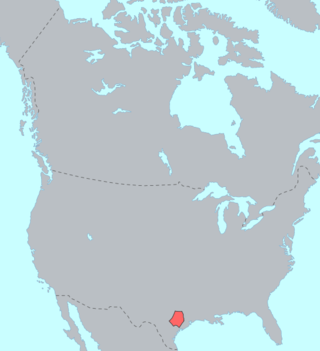
Klallam,Clallam, Ns'Klallam or S'klallam, is a Straits Salishan language that was traditionally spoken by the Klallam peoples at Becher Bay on Vancouver Island in British Columbia and across the Strait of Juan de Fuca on the north coast of the Olympic Peninsula in Washington. The last speaker of Klallam as a first language died in 2014, but there is a growing group of speakers of Klallam as a second language.

The Tonkawa language was spoken in Oklahoma, Texas, and New Mexico by the Tonkawa people. A language isolate, with no known related languages, Tonkawa has not had L1 speakers since the mid 1900s. Most Tonkawa people now only speak English, but revitalization is underway.

Kosraean is the language spoken on the islands of Kosrae (Kusaie), a nation-state of the Federated States of Micronesia, Caroline Islands. In 2001 there were approximately 8,000 speakers in Micronesia, and 9,060 in all countries.
Terence Michael Crowley was a linguist specializing in Oceanic languages as well as Bislama, the English-lexified Creole recognized as a national language in Vanuatu. From 1991 he taught in New Zealand. Previously, he was with the Pacific Languages Unit of the University of the South Pacific in Vanuatu (1983–90) and with the Department of Language and Literature at the University of Papua New Guinea (1979–83).

Erromango is the fourth largest island in the Vanuatu archipelago. With a land area of 891.9 square kilometres (344.4 sq mi), it is the largest island in Tafea Province, the southernmost of Vanuatu's six administrative regions.
The Nukuoro language is a Polynesian Outlier language, spoken by about 1,200 people on Nukuoro Atoll and on Pohnpei, two islands of Pohnpei State within the Federated States of Micronesia. Nukuoro is a remote coral atoll with a population of about 150, where the primary language is Nukuoro. An additional several hundred Nukuoro speakers live in Kolonia, Pohnpei, with smaller diaspora communities elsewhere in Micronesia and in the United States. Most Nukuoro speakers, particularly those that live away from Nukuoro Atoll, are multilingual in Pohnpeian and/or English; some older Nukuoro speakers also know German or Japanese.
Bardi is an endangered Australian Aboriginal language in the Nyulnyulan family, mutually intelligible with Jawi and possibly other dialects. It is spoken by the Bardi people at the tip of the Dampier peninsula and neighbouring islands. There are few fluent speakers in the 21st century, but efforts are being made to teach the Bardi language and culture at at least one school.
Apma is the language of central Pentecost island in Vanuatu. Apma is an Oceanic language. Within Vanuatu it sits between North Vanuatu and Central Vanuatu languages, and combines features of both groups.
Araki is a nearly extinct language spoken in the small island of Araki, south of Espiritu Santo Island in Vanuatu. Araki is gradually being replaced by Tangoa, a language from a neighbouring island.
Anejom̃ or Aneityum is an Oceanic language spoken by 900 people on Aneityum Island, Vanuatu. It is the only indigenous language of Aneityum.

Erromangan, or Sie (Sye), is the primary language spoken on the island Erromango in the Tafea region of the Vanuatu islands. The other Erromanga languages are either moribund or extinct. Although the island is quite large (887 km2), the total number of speakers of Erromango is estimated at 1900.
Paamese, or Paama, is the language of the island of Paama in Northern Vanuatu. There is no indigenous term for the language; however linguists have adopted the term Paamese to refer to it. Both a grammar and a dictionary of Paamese have been produced by Terry Crowley.
Ske is an endangered language of south-western Pentecost island in Vanuatu. Ske is an Oceanic language.
The Kwaio language, or Koio, is spoken in the centre of Malaita Island in the Solomon Islands. It is spoken by about 13,000 people.
Kadu or Kado is a Sino-Tibetan language of the Sal branch spoken in Sagaing Region, Myanmar. Dialects are Settaw, Mawkhwin, and Mawteik [extinct], with 30,000 speakers total.
Tommo So is a language spoken in the eastern part of Mali's Mopti Region. It is placed under the Dogon language family, a subfamily of the Niger-Congo language family.

Ute is a dialect of the Colorado River Numic language, spoken by the Ute people. Speakers primarily live on three reservations: Uintah-Ouray in northeastern Utah, Southern Ute in southwestern Colorado, and Ute Mountain in southwestern Colorado and southeastern Utah. Ute is part of the Numic branch of the Uto-Aztecan language family. Other dialects in this dialect chain are Chemehuevi and Southern Paiute. As of 2010, there were 1,640 speakers combined of all three dialects Colorado River Numic. Ute's parent language, Colorado River Numic, is classified as a threatened language, although there are tribally-sponsored language revitalization programs for the dialect.
Emae, or Fakamae, is a Polynesian outlier language of Vanuatu.
Ahamb, also spelled Axamb or Akhamb is an Oceanic language spoken in South Malakula, Vanuatu.
Nuaulu is a language indigenous to the island of Seram Island in Indonesia, and it is spoken by the Nuaulu people. The language is split into two dialects, a northern and a southern dialect, between which there a communication barrier. The dialect of Nuaulu referred to on this page is the southern dialect, as described in Bolton 1991.





